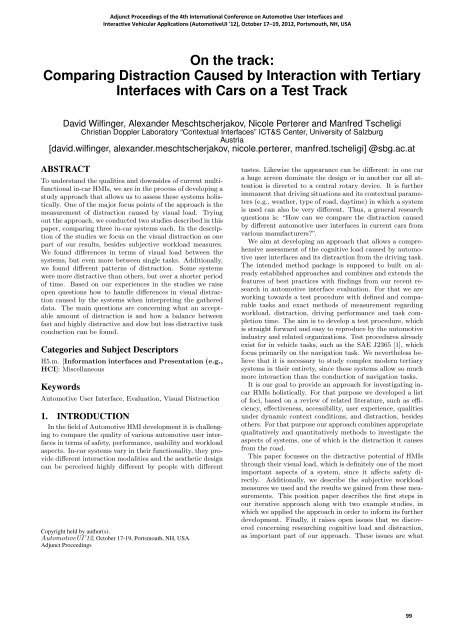12: Adjunct Proceedings - Automotive User Interfaces and ...
12: Adjunct Proceedings - Automotive User Interfaces and ...
12: Adjunct Proceedings - Automotive User Interfaces and ...
Create successful ePaper yourself
Turn your PDF publications into a flip-book with our unique Google optimized e-Paper software.
On the track:<br />
Comparing Distraction Caused by Interaction with Tertiary<br />
<strong>Interfaces</strong> with Cars on a Test Track<br />
David Wilfinger, Alex<strong>and</strong>er Meschtscherjakov, Nicole Perterer <strong>and</strong> Manfred Tscheligi<br />
Christian Doppler Laboratory “Contextual <strong>Interfaces</strong>” ICT&S Center, University of Salzburg<br />
Austria<br />
[david.wilfinger, alex<strong>and</strong>er.meschtscherjakov, nicole.perterer, manfred.tscheligi] @sbg.ac.at<br />
ABSTRACT<br />
To underst<strong>and</strong> the qualities <strong>and</strong> downsides of current multifunctional<br />
in-car HMIs, we are in the process of developing a<br />
study approach that allows us to assess these systems holistically.<br />
One of the major focus points of the approach is the<br />
measurement of distraction caused by visual load. Trying<br />
out the approach, we conducted two studies described in this<br />
paper, comparing three in-car systems each. In the description<br />
of the studies we focus on the visual distraction as one<br />
part of our results, besides subjective workload measures.<br />
We found di↵erences in terms of visual load between the<br />
systems, but even more between single tasks. Additionally,<br />
we found di↵erent patterns of distraction. Some systems<br />
were more distractive than others, but over a shorter period<br />
of time. Based on our experiences in the studies we raise<br />
open questions how to h<strong>and</strong>le di↵erences in visual distraction<br />
caused by the systems when interpreting the gathered<br />
data. The main questions are concerning what an acceptable<br />
amount of distraction is <strong>and</strong> how a balance between<br />
fast <strong>and</strong> highly distractive <strong>and</strong> slow but less distractive task<br />
conduction can be found.<br />
Categories <strong>and</strong> Subject Descriptors<br />
H5.m. [Information interfaces <strong>and</strong> Presentation (e.g.,<br />
HCI]: Miscellaneous<br />
Keywords<br />
<strong>Adjunct</strong> <strong>Proceedings</strong> of the 4th International Conference on <strong>Automotive</strong> <strong>User</strong> <strong>Interfaces</strong> <strong>and</strong><br />
Interactive Vehicular Applications (<strong>Automotive</strong>UI '<strong>12</strong>), October 17–19, 20<strong>12</strong>, Portsmouth, NH, USA<br />
<strong>Automotive</strong> <strong>User</strong> Interface, Evaluation, Visual Distraction<br />
1. INTRODUCTION<br />
In the field of <strong>Automotive</strong> HMI development it is challenging<br />
to compare the quality of various automotive user interfaces<br />
in terms of safety, performance, usability <strong>and</strong> workload<br />
aspects. In-car systems vary in their functionality, they provide<br />
di↵erent interaction modalities <strong>and</strong> the aesthetic design<br />
can be perceived highly di↵erent by people with di↵erent<br />
Copyright held by author(s).<br />
<strong>Automotive</strong>UI’<strong>12</strong>, October 17-19, Portsmouth, NH, USA.<br />
<strong>Adjunct</strong> <strong>Proceedings</strong><br />
tastes. Likewise the appearance can be di↵erent: in one car<br />
a huge screen dominate the design or in another car all attention<br />
is directed to a central rotary device. It is further<br />
immanent that driving situations <strong>and</strong> its contextual parameters<br />
(e.g., weather, type of road, daytime) in which a system<br />
is used can also be very di↵erent. Thus, a general research<br />
questions is: “How can we compare the distraction caused<br />
by di↵erent automotive user interfaces in current cars from<br />
various manufacturers?”.<br />
We aim at developing an approach that allows a comprehensive<br />
assessment of the cognitive load caused by automotive<br />
user interfaces <strong>and</strong> its distraction from the driving task.<br />
The intended method package is supposed to built on already<br />
established approaches <strong>and</strong> combines <strong>and</strong> extends the<br />
features of best practices with findings from our recent research<br />
in automotive interface evaluation. For that we are<br />
working towards a test procedure with defined <strong>and</strong> comparable<br />
tasks <strong>and</strong> exact methods of measurement regarding<br />
workload, distraction, driving performance <strong>and</strong> task completion<br />
time. The aim is to develop a test procedure, which<br />
is straight forward <strong>and</strong> easy to reproduce by the automotive<br />
industry <strong>and</strong> related organizations. Test procedures already<br />
exist for in vehicle tasks, such as the SAE J2365 [1], which<br />
focus primarily on the navigation task. We nevertheless believe<br />
that it is necessary to study complex modern tertiary<br />
systems in their entirety, since these systems allow so much<br />
more interaction than the conduction of navigation tasks.<br />
It is our goal to provide an approach for investigating incar<br />
HMIs holistically. For that purpose we developed a list<br />
of foci, based on a review of related literature, such as e -<br />
ciency, e↵ectiveness, accessibility, user experience, qualities<br />
under dynamic context conditions, <strong>and</strong> distraction, besides<br />
others. For that purpose our approach combines appropriate<br />
qualitatively <strong>and</strong> quantitatively methods to investigate the<br />
aspects of systems, one of which is the distraction it causes<br />
from the road.<br />
This paper focusses on the distractive potential of HMIs<br />
through their visual load, which is definitely one of the most<br />
important aspects of a system, since it a↵ects safety directly.<br />
Additionally, we describe the subjective workload<br />
measures we used <strong>and</strong> the results we gained from these measurements.<br />
This position paper describes the first steps in<br />
our iterative approach along with two example studies, in<br />
which we applied the approach in order to inform its further<br />
development. Finally, it raises open issues that we discovered<br />
concerning researching cognitive load <strong>and</strong> distraction,<br />
as important part of our approach. These issues are what<br />
99





